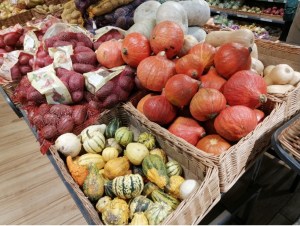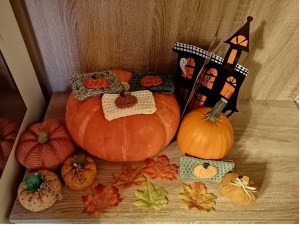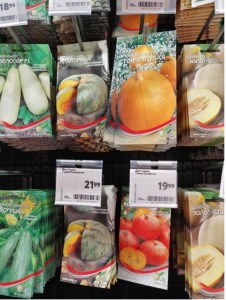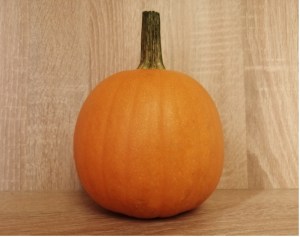We support our Publishers and Content Creators. You can view this story on their website by CLICKING HERE.
I live in Russia. Yes, still. And I’m a natural-born American with no Russian heritage. I even have a pretty great life here. But every year in October—or on the first day of September, if I’m being honest—something’s missing. That is the Perfect American Pumpkin. Like Linus anticipating the Great Pumpkin, I sincerely hope for the Perfect American Pumpkin to arise out of the Russian patch and appear before my eager eyes.
In 2017, I moved from the transcendent fall colors splayed across the gorges of Ithaca, New York, to St. Petersburg, Russia—where the first few leaves outside my window change from green to yellow in late August, then nothing else happens until the rest of them go brown in a flash and drop dead at the end of October. I moved from the land of fall festivals, twilit corn mazes at down-home farms, apple cider microbreweries, buying pumpkin-themed coffee cup cozies on Etsy, browsing wooden pumpkins at Hobby Lobby, and picking out the Perfect American Pumpkin at patches to the land of ugly, practical Pathetic Russian Pumpkins bred for taste, and taste alone. As Seinfeld quipped in an episode about a different Slavic nation, “Who leaves a country packed with p[umpkins] to come to a non-p[umpkin] country? It doesn’t make sense!”
During my first autumn in the biggest country in the world, I was deflated by the miserably pedestrian nature of the gourds on offer. Even the best orange pumpkins that older Russian folks grow at their dacha—a family country cottage, which most urban Russians seem to have—are lopsided, not evenly oranged, and rather more squat than your typical American offering.
Though the pumpkin is native to the Americas and not Eurasia, Russians can buy harvest-time pumpkins at the supermarket today just like Americans can. But the quality of the yield is far from comparable. For one thing, in the Russian language, squash and pumpkin share a name, tykva. While I would describe the Perfect American Pumpkin as round but tall, symmetrical, and a soft, yet bright, orange shade that is somewhere between deep yellow and red, Pathetic Russian Pumpkins/Squashes can be sorted into your five basic types: (1) squat, round pumpkins of a stripey orangish hue (called ulybka—smile, though they give me little to smile about), (2) squat, round pumpkins of a dusty greenish, almost grayish, tinge (lechebnaya—medicinal, mramornaya—marble, and kroshechka-khavroshechka—itty bitty Khavroshechka, an archaic female name), (3) round pumpkins in which the body part weirdly protrudes up into what should be the stem area, resembling a human breast with nipple, bearing an almost red color (rossiyanka—Russian and konfetka—candy), (4) oblong and beige, definitely a squash in English parlance though lumped in with pumpkins in the Russian patois (muskatnaya—butternut), and (5) assorted ghoulish yellow, green, and white grotesqueries that might be called squash in the United States but wouldn’t even be for sale uniformly there on account of their hideousness. This schema is by no means a comprehensive taxonomy of Russian pumpkins but includes those that served themselves up to me in my local supermarket, O’KAY, in October 2023.
None of these eyesores could constitute a display pumpkin for a self-respecting American.
Every fall, I want for two pumpkins, and only one has to be the Perfect American Pumpkin. The second is for baking pie. Since I was born on Thanksgiving, pumpkin pie is my birthday cake. It is a nonnegotiable accessory to a holiday that doesn’t exist where I live. Russia has no frozen pumpkin pies for sale, nor fresh from the bakery. Neither Libby’s puree cans nor any suitable facsimile lines supermarket shelves. Most pie pans for sale are angular. Pumpkin pie, just like the ornamental pumpkin itself, is a decidedly American obsession.
As historian Cindy Ott shows in her 2013 book Pumpkin: The Curious History of an American Icon, Americans have a unique relationship with the pumpkin. We are the only people in the world who historically venerate pumpkins as aesthetic objects before food—“pumpkins as furniture,” as Stephen Masty put in an essay for this journal. We alone have traditionally bred pumpkins to be photogenic rather than appetizing, and we avoid looking at the unsightly, tasty ones pureed into sterile, neatly stacked Libby’s cans the same way we avoid slaughterhouses. The resulting playful imagery of the harvest season distracts us from the fear of the symbolic death of imminent winter we feel with the encroaching cold and incremental nakedness of the trees and plants around us (depending on the climate in which we live).
In the American cartoon television special It’s the Great Pumpkin, Charlie Brown (1966), Linus shows his sister Lucy two different pumpkins, but neither is pretty enough, big enough, or all-around good enough to serve her Halloween display purposes. Her brother eventually shows Lucy a pumpkin that is bigger than she is, and she meets it with approval. But when Lucy starts carving the Perfect American Pumpkin, strewing its guts all over the floor, Linus screeches, “Oh, you didn’t tell me you were gonna kill it!” The Perfect American Pumpkin is distorted by its transformation into a jack-o’-lantern, but as a nonetheless symmetrical and eye-catching orb, it retains its usefulness through its deformation as a proper object of American vanity. Lucy finding the ideal party decoration sets up the main thrust of the 25-minute episode: while the rest of the Peanuts are Halloween partying, the hapless Linus misses out on the joy with a disappointing, quasi-religious wait in the pumpkin patch for the incarnation of the Great Pumpkin. The mystical vegetative beast allegedly rises out of the sincerest, least hypocritical pumpkin patch to distribute gifts to the “good” children of the world like some gourdish, autumnal version of Santa Claus. It’s the Great Pumpkin, Charlie Brown is an icon of American popular culture, appearing on television nearly every Halloween since 1966, with its prototypical vision of the holiday and its foremost symbol, the obligatory pumpkin.
In a personal essay called “Looking for Russia in America,” Zhanna Slor associates learning how to carve a pumpkin with learning how to become an American as a five-year-old immigrant. Slor could have chosen from an infinite number of cultural references to illustrate her blooming Americanness. But she chose the pumpkin.
Before my own transatlantic move, to conduct research for my PhD, I had about 10 years of adult experience buying fresh and frozen pumpkin pies for the autumn holidays. But I never made one myself. I didn’t need to. When my first November in Russia rolled around, I was dining out on one can of Libby’s, a petite jar of McCormick pumpkin pie spice, and even a premade graham cracker crust, all self-imported from the United States in my luggage. I had been doubtful that I would find the Perfect American Pumpkin Pie in Russia, and my doubts were confirmed. But that first year, just add eggs and condensed milk and, voilà!, you’ve got yourself a pie—albeit one with a super-dry, post-baking graham crust. Over the river and through the wood and across the world, “Hurrah for the pumpkin-pie!”
By the next year, I had to figure out how the sausage really gets made; I needed my first-ever unseemly-yet-edible Russian pumpkin. Thankfully, my future husband had the proper tools to puree pumpkin bricks into mush. But we pie-making-from-scratch novices didn’t know that pumpkin chunks have to be softened in the oven first. After our first attempt at pureeing orange cinder blocks failed, I turned to the English internets to rescue me from a harsh, Libby’s-less world. Besides being my first-ever pumpkin puree, it was my first-ever homemade pie crust.
We managed to fashion the Perfect American Pumpkin Pie, “bursting with country-fresh flavor” (another Seinfeld reference), but the Perfect American Pumpkin for display still eluded me. The Great Pumpkin teased me, failing to rise out of the pumpkin patch of St. Petersburg, though my belief in its existence was unshakeable. In early October 2023, when my eye homed in on a handknit or crocheted—I don’t know the difference—white pumpkin in a store window, I had a revelation: If I can’t find the Perfect American Pumpkin, I’ll have to find its inanimate analogue—the Perfect American Handmade Pumpkin.
Rising interest in homemade crafts is not limited to the United States. The archetype of American handicrafts is online store Etsy, founded in 2005, but Russia has its own methods for buying and selling crafts—particularly through national social media platform VKontakte (In Contact). Many of us increasingly love to buy cute handmade items that we can’t make ourselves; consider the trendy Bernie Sanders-with-mittens crocheted doll that sprang from the 2021 presidential inauguration. It is a sign of growing discontent with the mass-produced tripe sold uniformly in virtually every nation of the world, and the social media sameness to which we are all subjected, that people are looking more and more for handmade goods—even if they aren’t exactly one-of-a-kind but are small-batch imitations of what we see on Pinterest or Instagram. So much of life is now lived digitally, on a screen, that people long to be surrounded by lovely material and three-dimensional objects that reflect their personalities.
I’m no exception. My quest for the Perfect American Handmade Pumpkin began by typing ruchnaya rabota (“hand work,” or handicrafts) into VKontakte. I went with the first three stores that looked promising and close enough to each other that I could see them all in one afternoon. At the first, Na polke (On the Shelf), after 15 minutes of browsing jewelry and knickknacks by various and sundry craftspeople who rent their shelves by the month, my eyes located the singular color they were hunting—orange. Two sirenic miniature fabric pumpkins called to me from across the room. Their tawny strings gathered the fabric up to imitate the original article’s vertical ridges. Their stems were made of real wooden sticks with leaves of gray and bright green felt. Only one was Perfect American Pumpkin orange; the other was mustard yellow with delicate brown stars embedded in the print.
One fabric pumpkin cost what I had expected both to add up to together, but I couldn’t choose between them, each presenting with its own appealing features. I purchased both. Goofy grin plastered on my face, I collected my newfound cargo and headed over to 78 chudes (78 Wonders). After walking around a huge residential and commercial building three times, spotting no wonders, I scoured the store’s website on my phone for more information. The address was correct but offered nothing about what the “store” really was—a warehouse for an online store instead of a browsing spot. Shivering on the cold street in my fall jacket, inadequate for the latitude I found myself in, I quickly looked through the online store’s inventory, none of whose 78 treasures were seasonal delights. So, I made my way to the final store on my list, Polka room (Shelf Room). There, beckoning to me from across the (shelf) room sat a stunning bright orange sphere with olive green stem. The Perfect American Knit-or-Crocheted Pumpkin. It too cost more than I was expecting, but I happily spent nearly my last ruble for that pay period.
Three handmade pumpkins in one day did not complete my collection but only whet my appetite for more. Something about searching for a needle in a haystack makes the object of your desire more addictive than seeing it with every turn of your head. I began seeking out weekend craft fairs to source my pumpkin habit—only after the next payday, of course. By then, though, autumn was already receding in the rearview, and Perfect Handmade Christmas Trees were making their appearance at craft fairs, so I didn’t buy any more handmade pumpkins in 2023. I contented myself with the three musketeers and composed a note to self in my calendar to start my hunt earlier come 2024.
Admiring my fall-themed bounty back at my apartment, it struck me that one is never far from home. I must have the Perfect American Pumpkin because I’m an American. It doesn’t matter where I am in the world. Somehow, no other object tells me that I’m an American as much as gathering at least one alluring, impractical pumpkin purely for household ornamentation. Finally collecting my first handmade pumpkins after six years of living as an expatriate was like a declaration: This really is my home now. I can start nesting. But I had carried the United States with me abroad the way that Americans carry pumpkins home from the patch every fall.
From an economic point of view, collecting decorative live pumpkins makes little sense. The Economist calls pumpkin patches “pointless, lucrative and generally a force for good.” Indeed, pumpkins were a more than $134 million industry in the United States in 2022, according to the USDA. The top five ornamental pumpkin-producing states are California, Indiana, my home state of Michigan, Pennsylvania, and Virginia, with Illinois—Libby’s home state—producing virtually all of the processed pumpkins in the country and few of the decorative sort. The “pumpkin spice industrial complex” (this term is no joke) generated, in 2018, more than $600 million in revenue nationwide. We Americans gather pumpkins and their accoutrements every year because we can’t not do it. It’s who we are. We’re the world’s pumpkin collectors, the world’s pumpkin people. We’re pumpkin people the way that Mitch Albom and Morrie Schwartz are Tuesday people.
Living in a different country doesn’t change the fact that we’re pumpkin people. I’m a pumpkin person living in a non-pumpkin country. On my subway and bus rides in search of the Perfect American Handmade Pumpkin, I happened to be reading The Dream of the Great American Novel by Lawrence Buell (2014). Buell visited Cornell University as the annual Olin Lecture guest when I was a PhD student there, and student attendees got a free copy of his book. My quest for the Perfect American Pumpkin in Russia thus far mapped onto the trials and tribulations of the search for the Great American Novel; namely, it never ends and never produces the desired result—and not everyone can agree on which one is the right one anyway.
For me, a specialist in nineteenth-century American whaling, inter alia, the spouting Moby Dick on Buell’s cover was my primary impetus for reading about the elusive Great American Novel. The text of The (unfulfilled) Dream of the Great American Novel mocked me in my unfulfilled pursuit of the white whale of the Perfect American Pumpkin at great remove from home, through the canal-directed waters of St. Petersburg. I was a modern-day Captain Ahab, though less motivated by revenge, who would not rest until I found the object of my desire in a distant part of the world. I had Ahab- and Linus-like faith that I would meet my long-awaited prize. Like these two American heroes, I forewent other opportunities, like engaging with my friends, to devote time and energy to my monomaniacal quest.
By mid-October 2023, in my now-feverish pursuit of the Perfect American Pumpkin, I found myself face-to-face with packets of seeds lining one wall of O’KAY and raced for the orange-most section, snapping photos of all the tykvas the seeds promised to manifest. My eyes filled with wonder as they landed on a packet of seeds labeled krupnoplodnaya stofuntovaya. Stofuntovaya—100-pounder? Russians don’t even measure weight in pounds. Surely, this must be the Perfect American Pumpkin! The Great Pumpkin has arrived, huzzah! The image on the packet depicted a juicily colossal Perfect American “100-Pounder” Pumpkin. I’ll take these, thank you very much.
There was only one problem. I have no plot of land on which to grow a 100-pound gourd, or even a one-pound gourd. I live stacked up in a St. Petersburg apartment block like everybody else—except I don’t have my own dacha like everybody else. I guess I could buy the packet just to look at?
As much pleasure as looking at my slightly dirtied packet of seeds gave me, the quest for the Perfect American Pumpkin—which I needed to effect before Halloween, without growing it myself—continued. By late October 2023, I soothed myself with the thought that even if I never did find the Perfect American Pumpkin and had to make do with fabric likenesses, I, my Russian husband, and my nine-year-old Russian stepson would celebrate Halloween on October 31. We don no costumes, we celebrate alone, and our neighbors might even consider our mere celebration of Halloween satanic. You might too if you were suddenly, post-Sovietly, bombarded by the imagery of a new holiday without context. In fact, Halloween feels like the only holiday of the year that is just ours and no one else’s. On Halloween weekend 2023, out and about in the second largest city in Russia, I saw only one woman with a female child dressed up as a witch and a fairy, respectively, and three painted faces together, all appearing to be young women. On Halloween night, our little family tacked up some spooky decorations from my American friend on the wall. We watched an American horror film dubbed in Russian with English subtitles. We ordered pizza and cooked up some American popcorn, the latter of which most Russians only eat at the movies. We dug into our giant tub of American peanut butter that’s for sale in most supermarkets in Russia, even though no one we know buys it.
We even had our very own living Perfect American Pumpkin for Halloween to gaze upon with affection and admiration.
A few days before Halloween, I had meandered into Marketplace, a small franchise of cafeteria-style restaurants where customers pick up gourmet food prepared at themed stations. My favorite is the pasta station, and I often swing by the salad station to get a Greek salad after placing my rice-noodles-with-chicken order. But before I made it to the pasta station, I was stopped in my tracks by a stunning autumnal display featuring more Perfect American Pumpkins than I could count.
They weren’t for sale because no self-respecting Russian would buy raw produce in a restaurant.
In amazement at the bounty before me, I fondled the smaller ones—i.e., the ones portable in my handbag since I’m a city girl without a car—and the Cheshire cat grin of Gollum caressing the one ring to rule them all slid onto my face. Pushing aside fake spider webs, I picked up one particularly bright orange and symmetrical item, weighing it in my palm. The thought flashed, If I just turned around and walked out with this pumpkin, would anybody care? Unbidden, my free hand started rearranging pumpkins to hide the gap left behind by the one in my grasp.
Hesitating in horror, quickly reminding myself that I’m not a person who steals—even something that has no value to its owner, especially at the end of the local Thanksgiving-less pumpkin season—and that foreigners in any country of the world can be deported for less, I shuffled the lesser pumpkins aside and put My Precious back. I resolved to ask a cashier a most awkward question in a country where nobody cares about decorative pumpkins. As a mumbly foreigner who sometimes struggles to be understood in Russian, I would need an Exhibit A to illustrate my point. I gathered My Precious back into my hands—not reshuffling the remainder this time—climbed the three sideways entry steps that hid the entry display from the employees’ view, and crossed the few meters to the end of the food stations. On the way, I nervously recited what I intended to say in my head, in my funky Russian.
At the paying station, I awkwardly looked up at a young woman cashier.
“Um, excuse me, can I buy this pumpkin out of you?”
“What?”
“Can I buy this pumpkin out of you? Like, to fling around my apartment with?” (Holding Exhibit A higher for emphasis, hoping that its evident sublime beauty would wordlessly convey to the cashier that I am from the tribe of the pumpkin people.) “How much cost would it?”
(With a mix of confusion and apathy.) “No… they aren’t for sale.”
We were clearly sundered by denominational differences. Linus was right when he said never to discuss three things with people: politics, religion, and the Great Pumpkin.
Dejected, I slunk to the exit, embarrassed at putting my foreignness on conspicuous display, against which I toil daily. I had lost my appetite for rice noodles with chicken.
I slept that night with visions of Perfect American Pumpkins in my head. Giant ones, dainty ones, Jack Be Littles, all bright orange, all symmetrical, some spread with fake spider webs linking them ethereally to others. The next morning, I couldn’t stop thinking about My Precious and concluded that surely I could find a phone number for Marketplace’s owner. Surely a reasonable person could be persuaded that I needed one of their pumpkins. I found an email address and started crafting a bizarre request to an owner with a decidedly Russian first name and decidedly English last name (is Bork in Russian like Bourque in English—a last name possessed of one of my elementary school classmates?). Do I need to explain that Americans are pumpkin people? Or does she already know? If I ask to buy one of her pumpkins, won’t I just find myself in this same predicament again next year? I settled on asking Ms. Bork directly for her pumpkin source so I could keep my supply on tap for years to come.
Ms. Bork kindly answered my email but ignored my desire to liaison with her source. She offered to let me come in anytime and take any pumpkins I wanted for free. “Just be sure to tell the manager, who knows you’ll be coming in.”
The knowing manager smirked with the frivolity of the scene as I waved My Precious before her eyes, bid her a hearty spasibo, turned around, and walked out of Marketplace with my Perfect American Pumpkin in tow—most likely the selfsame Exhibit A I had put my fingerprints on a few days previously. Her grin extended to my face as I hauled away My Precious. My lack of hypocrisy rewarded, the Perfect American Pumpkin had delivered itself into my sincerely waiting arms.
Glancing back at the manager before leaving, my bag heavy, I said to myself, See you again next fall.
The Imaginative Conservative applies the principle of appreciation to the discussion of culture and politics—we approach dialogue with magnanimity rather than with mere civility. Will you help us remain a refreshing oasis in the increasingly contentious arena of modern discourse? Please consider donating now.
The images above are courtesy of the author. The featured image is courtesy of Pixabay.

 Conservative
Conservative  Search
Search Trending
Trending Current News
Current News 









